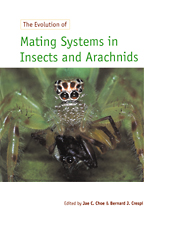Book contents
- Frontmatter
- Contents
- Contributors
- Acknowledgements
- Introduction
- 1 Evolutionary perspectives on insect mating
- 2 Sexual selection by cryptic female choice in insects and arachnids
- 3 Natural and sexual selection components of odonate mating patterns
- 4 Sexual selection in resource defense polygyny: lessons from territorial grasshoppers
- 5 Reproductive strategies of the crickets (Orthoptera: Gryllidae)
- 6 The evolution of edible ‘sperm sacs’ and other forms of courtship feeding in crickets, katydids and their kin (Orthoptera: Ensifera)
- 7 The evolution of mating systems in the Zoraptera: mating variations and sexual conflicts
- 8 The evolution of water strider mating systems: causes and consequences of sexual conflicts
- 9 Multiple mating, sperm competition, and cryptic female choice in the leaf beetles (Coleoptera: Chrysomelidae)
- 10 Firefly mating ecology, selection and evolution
- 11 Modern mating systems in archaic Holometabola: sexuality in neuropterid insects
- 12 Mating systems of parasitoid wasps
- 13 Fig–associated wasps: pollinators and parasites, sex–ratio adjustment and male polymorphism, population structure and its consequences
- 14 Evolution of mate–signaling in moths: phylogenetic considerations and predictions from the asymmetric tracking hypothesis
- 15 Sexual dimorphism, mating systems and ecology in butterflies
- 16 Lek behavior of insects
- 17 Mate choice and species isolation in swarming insects
- 18 Function and evolution of antlers and eye stalks in flies
- 19 Sex via the substrate: mating systems and sexual selection in pseudoscorpions
- 20 Jumping spider mating strategies: sex among cannibals in and out of webs
- 21 Sexual conflict and the evolution of mating systems
- Organism index
- Subject index
18 - Function and evolution of antlers and eye stalks in flies
Published online by Cambridge University Press: 03 May 2010
- Frontmatter
- Contents
- Contributors
- Acknowledgements
- Introduction
- 1 Evolutionary perspectives on insect mating
- 2 Sexual selection by cryptic female choice in insects and arachnids
- 3 Natural and sexual selection components of odonate mating patterns
- 4 Sexual selection in resource defense polygyny: lessons from territorial grasshoppers
- 5 Reproductive strategies of the crickets (Orthoptera: Gryllidae)
- 6 The evolution of edible ‘sperm sacs’ and other forms of courtship feeding in crickets, katydids and their kin (Orthoptera: Ensifera)
- 7 The evolution of mating systems in the Zoraptera: mating variations and sexual conflicts
- 8 The evolution of water strider mating systems: causes and consequences of sexual conflicts
- 9 Multiple mating, sperm competition, and cryptic female choice in the leaf beetles (Coleoptera: Chrysomelidae)
- 10 Firefly mating ecology, selection and evolution
- 11 Modern mating systems in archaic Holometabola: sexuality in neuropterid insects
- 12 Mating systems of parasitoid wasps
- 13 Fig–associated wasps: pollinators and parasites, sex–ratio adjustment and male polymorphism, population structure and its consequences
- 14 Evolution of mate–signaling in moths: phylogenetic considerations and predictions from the asymmetric tracking hypothesis
- 15 Sexual dimorphism, mating systems and ecology in butterflies
- 16 Lek behavior of insects
- 17 Mate choice and species isolation in swarming insects
- 18 Function and evolution of antlers and eye stalks in flies
- 19 Sex via the substrate: mating systems and sexual selection in pseudoscorpions
- 20 Jumping spider mating strategies: sex among cannibals in and out of webs
- 21 Sexual conflict and the evolution of mating systems
- Organism index
- Subject index
Summary
ABSTRACT
Flies with structures protruding from the head, termed eye stalks or antlers, have long fascinated biologists. In this chapter we consider the possibility that such flies either share developmental predispositions to head modification or face similar selective pressures to augment head width. By randomizing the occurrence of eye stalks and antlers among families of acalyptrate flies over a phylogeny, we demonstrate that eye stalks and antlers have evolved especially often within one superfamily and that eye stalks and antlers exhibit correlated evolution. Because extreme sexual dimorphism of antlers and eye stalks occurs in four families, while correlated evolution of eye stalks in females occurs in others, we suggest that the degree of sexual dimorphism, but not the occurrence of head projections, has been influenced by historical genetic factors. Comparison of the ecology and mating systems of flies from the genus Phytalmia, all species of which possess antlers, with flies from the family Diopsidae, all species of which possess eye stalks, indicates selective similarities. All headprojection flies studied to date exhibit some form of resource–defense mating system. Phytalmia spp. defend rare oviposition sites, whereas dimorphic diopsids defend protected sites where females aggregate at night. In both groups, males assess the body size of competitors from the head projection, and males of similar size engage in extended physical contests for control of a resource. Females of at least two diopsid species also use eye–stalk length to select mates and can influence sperm precedence by ejecting male spermatophores.
Information
- Type
- Chapter
- Information
- The Evolution of Mating Systems in Insects and Arachnids , pp. 310 - 328Publisher: Cambridge University PressPrint publication year: 1997
Accessibility standard: Unknown
Why this information is here
This section outlines the accessibility features of this content - including support for screen readers, full keyboard navigation and high-contrast display options. This may not be relevant for you.Accessibility Information
- 93
- Cited by
